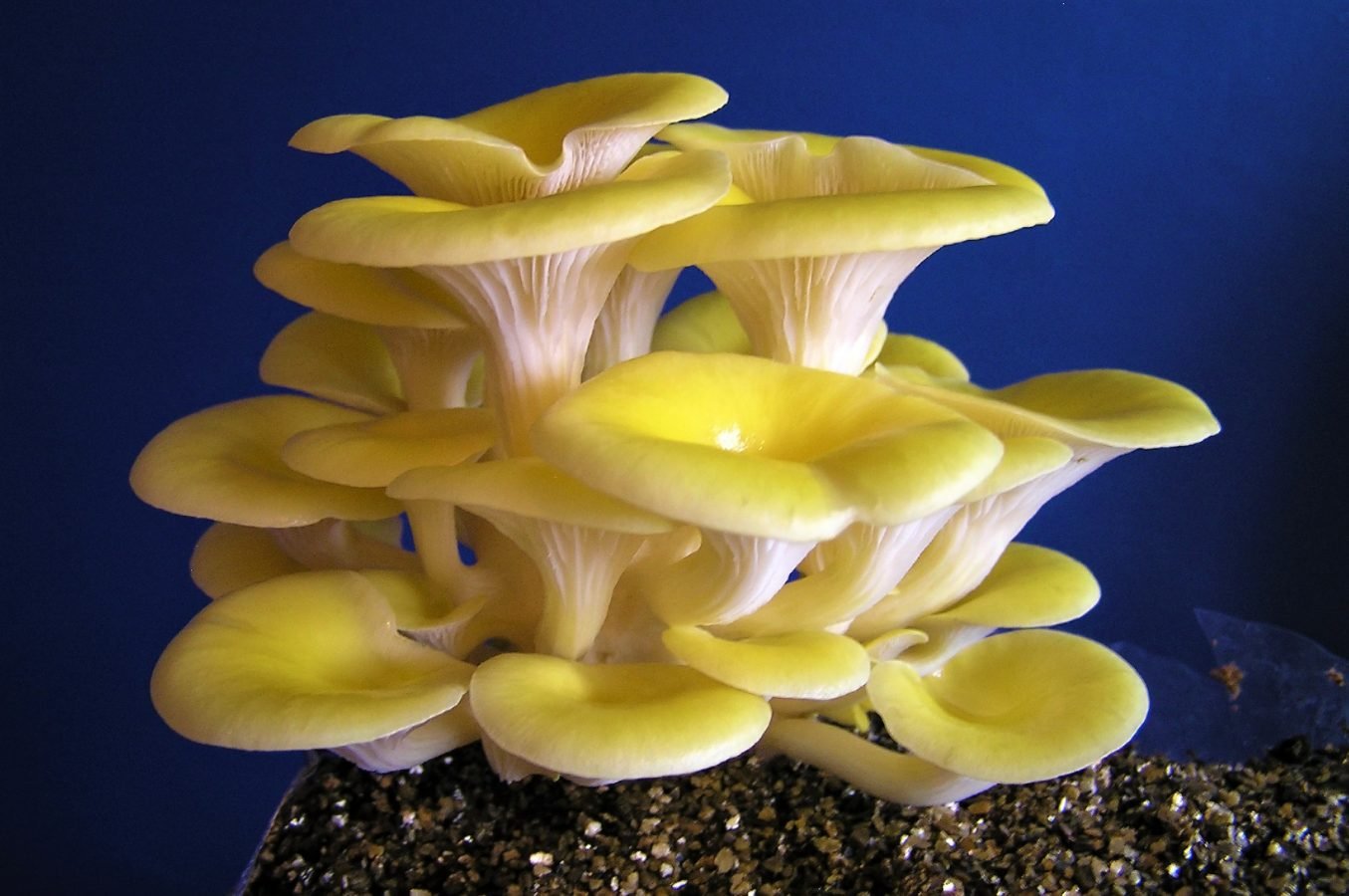Yellow Oyster
(Pleurotus Citrinopileatus)
Pleurotus citrinopileatus, the golden oyster mushroom (tamogitake in Japanese), is an edible gilled fungus. Native to eastern Russia, northern China, and Japan, the golden oyster mushroom is very closely related to P. cornucopiae of Europe, with some authors considering them to be at the rank of subspecies. The fruiting bodies of P. citrinopileatus grow in clusters of bright yellow to golden brown caps with a velvety, dry surface texture. Caps range from 20–65 millimetres (3⁄4–2+1⁄2 inches) in diameter. The flesh is thin and white, with a mild taste and without a strong smell.
Patience & Waiting Stage - Spawn Run/Colonization
1. Spawn Run (Colonization) – allow inoculated mushroom grow kit to incubate at room temperature. This will take 2 to 3 weeks. Move onto next stage once grow kit is dense and uniformly covered with white mycelium.
Observation Stage - Primordial/Pinhead Formation
2. Pinning (Initiate Mushroom Formation) – Drop Temperature, increase Relative Humidity. Watch for mycelium to form Pin like growths and small mushrooms. Move onto the next stage once mushrooms are visible. The mycelium should start turning pinkish white, this is a good sign that you’re ready to progress to the next stage.
Action Stage - Fruiting
3. Cut small x or poke 1/8” holes in the side of the bag for mushrooms to grow through. Alternatively with the gusseted plastic bags simply cut off the top of the bag and gentle roll/fold the bag down to the top of the mushroom block.
4. Fruiting (Mushroom Formation) – Adjust Temperature and Relative Humidity. Provide plenty of Fresh Air (Oxygen). First harvest of Mushrooms will occur within 1 week.
Days 5 - 6 Maturity
Yummy Stage - Harvest
5. The perfect time to harvest your Yellow Oysters is when the mushroom cap is flat to slightly concaved, as shown by the blue arrows. Make sure to grab any little mushrooms that may have grown together along the stem. You can also harvest the mushrooms when they’re a good size before the cap flattens out, the earlier you harvest the more tender, soft and succulent Yellow Oyster Mushrooms will be. The more mature mushrooms tend to have more woody, snap like bite.
Renew/Flushing Stage - Crop Cycle
6. With clean water submerge the wooden block for 3 to 5 hours, weight it down if necessary. This will re-hydrate the wooden substrate material and provide the mycelium with much needed moisture. Place the mycelium block back into a clean bag and close off to simulate underground conditions, this will allow the mycelium time to regenerate. Watch for pin formation and carefully monitor for signs of contamination.
Note: that it may not be necessary to refresh the block after the first harvest, keep an eye out for other groupings of mushrooms forming else were on the block. Best time to refresh/rehydrate the block is when there is no growths.
Refer to Grow Guide for more details.
Health Benefits:
Pleurotus citrinopileatus mushrooms are a source of antioxidants. Extracts from P. citrinopileatus have been studied for their antihyperglycemic properties, decreasing blood sugar levels in diabetic rats.[8] They have also been studied as a source of lipid-lowering drugs;[9] P. ostreatus, a related oyster mushroom, has been found to contain the cholesterol-lowering drug lovastatin.
In one study, among 11 other commonly cultivated or foraged mushroom species, Pleurotus citrinopileatus contained the second highest amount of the antioxidant and amino acid ergothioneine at 3.94mg per gram of dry weight, and fourth highest in glutathione at 1.39mg per gram of dry weight. Both compounds had their highest concentrations in the pileus tissue. It had the highest amount of ergothioneine among the other saprotrophs within the group.
Summary:
Texture/Flavor: Tender, succulent , sweet, woody, and Aromatic
Difficulty: Easy
Growing Conditions: 20 - 30°C, 85 - 90% humidity Nutrients: Anti-Oxidants, β-glucan/Fiber, Vitamin B, Copper, Potassium.
Common Uses: Pastas, Stir Fries, or Sautéed
Tip: Season with a bit of paprika to bring out a more meaty bacon/ham flavor.






